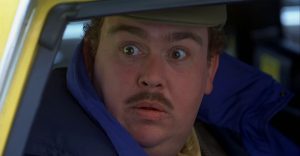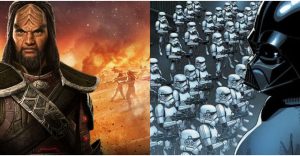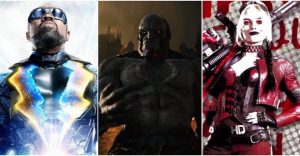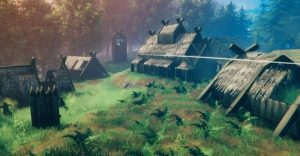Dominion Is Fixing Jurassic World’s Hybrid Dinosaur Mistakes

Jurassic World: Dominion is set to introduce a raft of new dinosaurs into the lucrative prehistoric franchise, yet is simultaneously fixing some of the saga’s biggest mistakes – specifically around the use of hybrid dinosaurs. The early trailers for the delayed dinosaur blockbuster have already thrilled fans with the promise of multiple new species. However, it is by diverging from a now-established trope of increasingly bizarre and outlandish hybrid creations that the movie looks set to go back to basics and correct some of the previous Jurassic World movies’ more ridiculous tendencies.
Following on from the events of Jurassic World: Fallen Kingdom, Dominion takes place in a world where dinosaurs have established a firm foothold alongside humanity. Released footage reveals Jurassic World franchise stalwarts Owen Grady and Claire Dearing teaming up with series icons Alan Grant, Ellie Satler and Ian Malcolm in a bid to chart a course through this new world order. As the tone of the trailers implies, the presence of dinosaurs on Planet Earth 65 million years after their extinction poses some serious problems, beyond the very real risk of being eaten.
The prospect of popular characters past and present reuniting for Jurassic World: Dominion is certain to make the movie one of 2022’s biggest cinematic releases. However, for the future of the Jurassic franchise, it is the apparent absence of the hybrid dinosaurs that have been the major antagonists in each Jurassic World movie to date that is the biggest win for fans. Not only did dinosaurs like the Indominus Rex and Indoraptor boast a growing collection of unrealistic abilities, but the series’ over-reliance on them to create a sense of jeopardy was becoming increasingly stale. As a result, the franchise’s apparent decision to reject the dinosaur hybrid narrative could be what makes Jurassic World: Dominion the most successful entry in the sub-series yet.
Hybrid Dinosaurs Were Ruining Jurassic World

When the first dinosaur hybrid made its debut in Jurassic World back in 2015, the concept enjoyed a generally warm reception. While there were many things about the sequel that didn’t work for fans, such as Claire Dearing’s ability to outrun a Tyrannosaurus in high heels, many viewers felt that using advanced genetics to create an animal more monstrous than anything produced in nature was a natural step for the famously inconsiderate InGen. However, while the advent of Indominus Rex made for an innovative villain, the hybrid concept quickly lost steam.
One of the major problems was the decision to repeat the trick for Jurassic World: Fallen Kingdom. The introduction of the even more grotesque Indoraptor during the movie’s manor house climax inadvertently reinforced the notion that the franchise had run out of original ideas and was simply repackaging once novel concepts. Given the disaster that befell Jurassic World thanks to a hybrid, it stretched the realms of credulity that the same people responsible would make the same mistakes all over again, only this time on the mainland. Ultimately, the fact that both Jurassic World entries revolved around a genetically enhanced opponent gave long-time viewers the impression that the series was stuck retreading old ground.
It didn’t help matters that arguably the best iteration of the hybrid dinosaur conceit didn’t even make it to the big screen. Netflix’s spin-off series, Camp Cretaceous, which chronologically took place alongside the events of Jurassic World, introduced a much more sinister opponent than either the Indominus Rex or the Indoraptor in the form of the twisted Scorpios Rex. Not only was E750 genuinely terrifying, but it served to highlight how cartoonish the Indoraptor and Indominus Rex were by contrast (even more ironic, considering that the Scorpios Rex was literally part of an animated sideshow). Had another hybrid been front and center of Jurassic World: Dominion, there’s a very real possibility that audiences would have lost patience with a series that was demonstrably over-saturated with riffs on the same central premise.
Real Jurassic Park Dinosaurs Have Always Been Better

While the hybrids of Jurassic World clearly have some gimmicky appeal, they cannot hold a candle to the true stars of the series. As much as audiences tune in to see over-the-top, popcorn-worthy action, part of what makes the Jurassic Park franchise so enduring is the excitement viewers still get from seeing their favorite dinosaurs brought to life. For all the spectacle of seeing Indominus Rex munch its way through an elite team of faceless mercenaries, nothing in the Jurassic World series has been able to recapture the magic of the original movie’s T. Rex battle in the rain.
Even though Jurassic Park is inherently ridiculous, it is a sci-fi series that is arguably more rooted in realism than many of its blockbuster competitors. Part of what made the early movies so compelling was a sense that, despite real scientists’ scorn, what John Hammond and InGen were doing might just be possible. This edge, however, completely disappeared with the introduction of a velociraptor/cuttlefish amalgamation that could become invisible at will. By removing this more fantastical element from the movie, Jurassic World: Dominion can actually create something much more engaging that feels true to the tone of the first movie. In the process, it can also honor the actual dinosaurs that made the series such a success in the first place.
Why There Still Might Be Hybrids In Dominion

Though the first trailers indicate that there won’t be anything as preposterous as a vanishing 50ft lizard in Jurassic World: Dominion, it may be that the specter of the hybrids still plays a part throughout the movie. A close-up of a hirsute Henry Wu, an ominous DNA animation, as well as unusual dinosaurs not yet seen in other Jurassic Park movies all indicates that unethical experimentation could play a key role. Nevertheless, the footage also indicates that unless the movie springs a major surprise, any new creations will be much more realistic than some of the series’ previous introductions.
Take, for instance, the brightly-colored, feathered theropod that attacks Owen and the as-yet-unnamed new character. Given the radical difference between this creature and the other, completely scaly dinosaurs that have dominated Jurassic Park so far, this could represent the next step in Jurassic World genetic experimentation. However, the animal is also incredibly similar to the Pyroraptor – a very real predator that lived in Southern Europe during the Late Cretaceous. The presence of this dinosaur, alongside other unusual species such as the Therozinosaurus, suggests a level of commitment to realism that has arguably been lacking in the Jurassic World series to date. The fact that these bizarre yet completely real animals are being given screentime over a made-up hybrid suggests that Jurassic World: Dominion is indeed committed to offering a course correction for the rest of the franchise.
- Jurassic World: Dominion (2022)Release date: Jun 10, 2022
About The Author


















